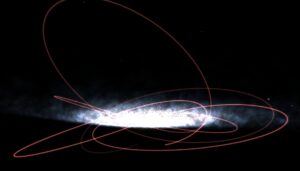
The universe we see doesn’t always reflect the universe that is out there. Luckily for us, a lot of dark details can’t stay hidden for long because their motion gives them away.
The Gaia spacecraft was launched in 2013 on a mission to measure the precise locations of every point and smudge of light visible to the craft’s weird rectangular mirrors. With the ability to see motions across the sky that are just fractions of a hair’s width in size, Gaia has been able to see stars in binary systems move in their orbits.
And it has seen more than a few stars moving with no visible companion.
One of these lone points of light is moving in a way consistent with the presence of a 33-solar mass black hole failing to shine as its partner.
This star, a 0.76-solar mass elder giant is on a nearly 12-year orbit around something that has nearly 33 solar masses of material. Something that isn’t giving off light.
And a black hole fits the bill. The elder star is very low on heavy elements, and low metalicity stars like this have the potential to start out very, very large. It’s possible that this was once a binary system with a small star and a star of unusual size. While the smaller star is still there and evolving very slowly, the larger could have lived and died and formed a black hole that we’re now failing to see except through its gravitational pull. It’s also possible that there is a pair of smaller black holes, or maybe even a black hole and a neutron star, that is beyond the abilities of Gaia to see. Hopefully, follow-up data will better constrain what dark monster is pulling around the one visible star. For now, there is the potential that Gaia has found the new record holder for the largest stellar black hole.
